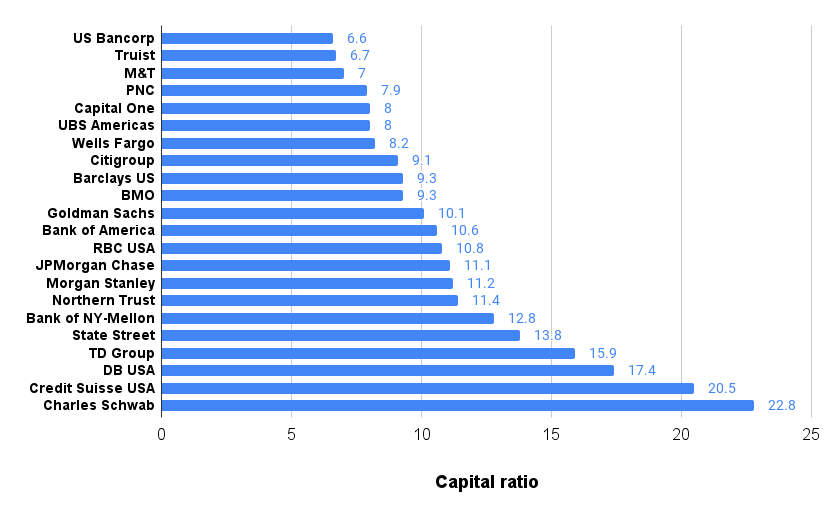
In these times, double down — on your skills, on your knowledge, on you. Join us Aug. 8-10 at Inman Connect Las Vegas to lean into the shift and learn from the best. Get your ticket now for the best price.
Mortgage rates could be headed to new 2023 highs as good news about the economy — a fall in jobless claims, an upward revision to second-quarter GDP and the Federal Reserve issuing passing grades on bank stress tests — increases the odds of future Federal Reserve rate hikes.
Yields on 10-year Treasury notes, which are often a good indicator of where mortgage rates are headed next, spiked Thursday to the highest level since March as investors reacted to the changing picture on inflation.
10-year Treasury yield spikes Thursday
Thursday’s high yield on the 10-year note of 3.87 percent was short of the 2023 high of 4.09 percent seen on March 2. But 10-year yields are more than half a percentage point higher than the low for the year of 3.25 percent registered on April 6, when there was less certainty about future Fed rate hikes.
In their efforts to combat inflation, Federal Reserve policymakers have been focused on a tight job market that’s put upward pressure on wages. Thursday’s report from the Department of Labor showing unemployment claims posted the biggest drop in 20 months last week caught many analysts by surprise and could be concerning to Fed policymakers if the trend holds.
The Department of Labor said jobless claims during the week ending June 24 dipped by 26,000 to a seasonally adjusted 239,000. Economists polled by Reuters had forecast there would be 265,000 unemployment claims.
The four-week moving average for jobless claims remains at 257,500 — the highest since the week ending November 13 2021 — and the numbers for individual weeks always “have to be viewed with skepticism, especially when they move against the established trend in claims and other data,” analysts with Contingent Macro Research said in a note to clients.
On June 2, the Labor Department reported that employers added 339,000 jobs in May. While the unemployment rate rose by 0.3 percentage points to 3.7 percent, payroll growth exceeded many economists’ expectations and marked 29 consecutive months of positive job growth.
Adding to the case that Fed policymakers will still be worried about inflation at their July 26 meeting was another surprising report Thursday from the Commerce Department, which showed the U.S. economy grew at a 2 percent annual pace during the first quarter of the year.
Real GDP growth surprises to the upside

While economic growth as measured by real gross domestic product (GDP) is decelerating, first-quarter growth exceeded a previous estimate of 1.3 percent.
“Compared to the fourth quarter, the deceleration in real GDP in the first quarter primarily reflected a downturn in private inventory investment and a slowdown in nonresidential fixed investment,” the Commerce Department’s Bureau of Economic Analysis said in an announcement. Those trends were “partly offset by an acceleration in consumer spending, an upturn in exports, and a smaller decrease in residential fixed investment. Imports turned up.”
While the Fed has been trying to rein in consumer spending by making it more costly to borrow, consumer spending rose at a 4.2 percent annual rate in Q1, the most since the second quarter of 2021.
Another piece of good news for the economy that could add to inflationary pressure, the Federal Reserve on Wednesday published the results of its annual stress tests of banks, which shows the 23 banks subject to testing could endure a severe recession while continuing to lend.
Big bank capital ratios under ‘severely adverse’ economic scenario

Source: 2023 Federal Reserve Stress Test Results
The 2023 stress test shows that the 23 large banks subject to the test “have sufficient capital to absorb more than $540 billion in losses and continue lending to households and businesses under stressful conditions,” regulators said.
Under the severely adverse scenario, the aggregate common equity tier 1 (CET1) capital ratio of the 23 banks would fall from an actual 12.4 percent in the fourth quarter of 2022 to its minimum of 10.1 percent, before rising to 10.7 percent at the end of the projection.
The Fed wants to see CET1 capital ratios stay above 4.5 even if the stock market were to crash by 45 percent and unemployment soared to 10 percent. All of the banks passed that test, with variation between banks due to differences in their business lines, portfolio composition and securities and loan risk characteristics that drive changes in the magnitude and timing of loss, revenue and expense projections, regulators said.
“It’s not the 23 largest banks that were tested that people are worried about,” Annex Wealth Management Chief Economist Brian Jacobsen told Reuters. “It’s the more than 4,000 smaller banks that people are curious about.”
Federal Reserve policymakers have said stresses on regional banks sparked by the failures of Silicon Valley Bank, Signature Bank and First Republic Bank could curb lending and help cool inflation. Fannie Mae economists warned in March that jumbo loans exceeding Fannie and Freddie’s $727,200 conforming loan limit could get hard to come by, for example.
For much of June, rates on jumbo loans have been higher than those for conforming mortgages eligible for purchase by Fannie and Freddie, with the average spread between jumbo and conforming rates widening to 16 basis points last week, according to the Mortgage Bankers Association.
But the results of the Federal Reserve’s latest bank stress test suggest that big banks, at least, aren’t facing capital constraints that would force them to pull back on lending to consumers and businesses.
July Fed rate hike now seen as certain
This week’s good economic news has investors buying stocks and selling bonds over worries that Fed policymakers will continue hiking rates to combat inflation. Adding to the inflationary pressures are recent strengths in home prices driven by inventory shortages in many markets.
Hiking rates to fight inflation
The Federal Open Market Committee has approved 10 increases in the federal funds rate since March 2022, bringing the short-term federal funds rate to a target of between 5 percent and 5.25 percent. Federal Reserve policymakers expect two more 25-basis point rate increases this year, before bringing the benchmark rate back down next year.
The CME FedWatch Tool, which monitors futures markets to measure investor expectations about the Fed’s next moves, puts the odds of another 25-basis point Fed rate hike in July at 87 percent. But futures markets predict only a 24 percent chance of another rate hike in September.
In a forecast released Monday, economists at Fannie Mae predicted that while the economy is performing better than expected, Fed tightening is likely to lead to a “modest recession” in the final three months of 2023 and sales of existing homes will fall by 16.2 percent this year to 4.213 million.
Get Inman’s Mortgage Brief Newsletter delivered right to your inbox. A weekly roundup of all the biggest news in the world of mortgages and closings delivered every Wednesday. Click here to subscribe.





